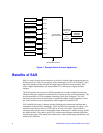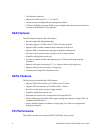Intel® RAID Controller SRCSAS18E User’s Guide 2
SAS Controller Description
The RAID Controller SRCSAS18E is available with eight ports via two x4 SFF8484
connectors. The RAID Controller SRCSAS18E has one Intel
®
IOP333 I/O processor that
controls the SAS interface.
The RAID Controller SRCSAS18E brings 3.0 Gbit/s Serial Attached SCSI and 3.0 Gbit/s
SATA performance to host adapter, workstation, and server designs. The controller
support internal storage devices and allows you to use a system that supports enterprise-
class SAS and desktop-class SATA drives.
The SAS controller integrates eight high-performance SAS/SATA phys. Each of the eight
phys is capable of 3.0 Gbit/s SAS link rates, and 3.0 Gbit/s SATA link rates.
The SAS RAID controller supports the SAS protocol as described in the Serial Attached
SCSI Standard, version 1.0, as well as SAS 1.1 features. The controller also supports the
Serial ATA protocol defined by the Serial ATA specification, version 1.0a. In addition, the
SAS RAID controller supports the following SATA features:
• 3 Gbit/s SATA
• Staggered spin-up
• Hot Plug
• Native Command Queuing (NCQ)
Note: Available with TA D46199-003 or later only.
• Activity and fault indicators per phy
• Port Selector (for dual-port drives)
Each port on the SAS controller supports SAS and SATA devices using the SAS Serial
SCSI Protocol (SSP), Serial Management Protocol (SMP), Serial Tunneling Protocol
(STP), and SATA. The SSP protocol enables communication with other SAS devices.
SATA enables the SAS controller to communicate with other SATA devices. The SAS
RAID controller supports a x8 PCI Express interface.
Configuration Scenarios
The following scenerio is an example of how to use the SAS controller on the RAID
Controller SRCSAS18E:
• Low-end, internal SATA configurations: as a high-end SATA-compatible controller
that connects up to eight disks either directly or through a port expander. Enclosure
management through out-of-band I2C. Mostly for low end or entry servers
• Midrange internal SAS configurations: like internal SATA configurations, but with
high-end disks. Suitable for low- to mid- range servers.
Figure 1 shows a direct-connect configuration.


















